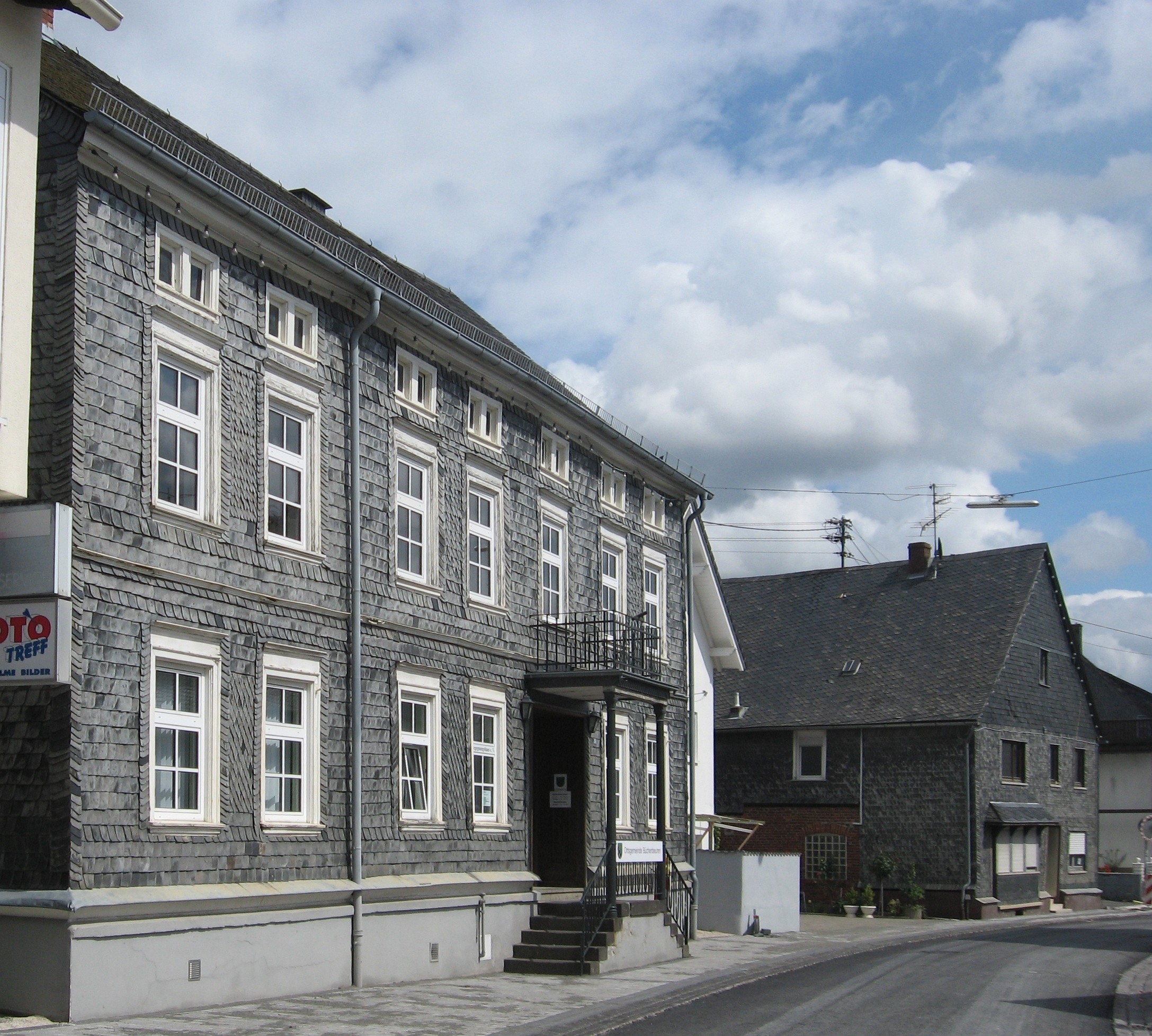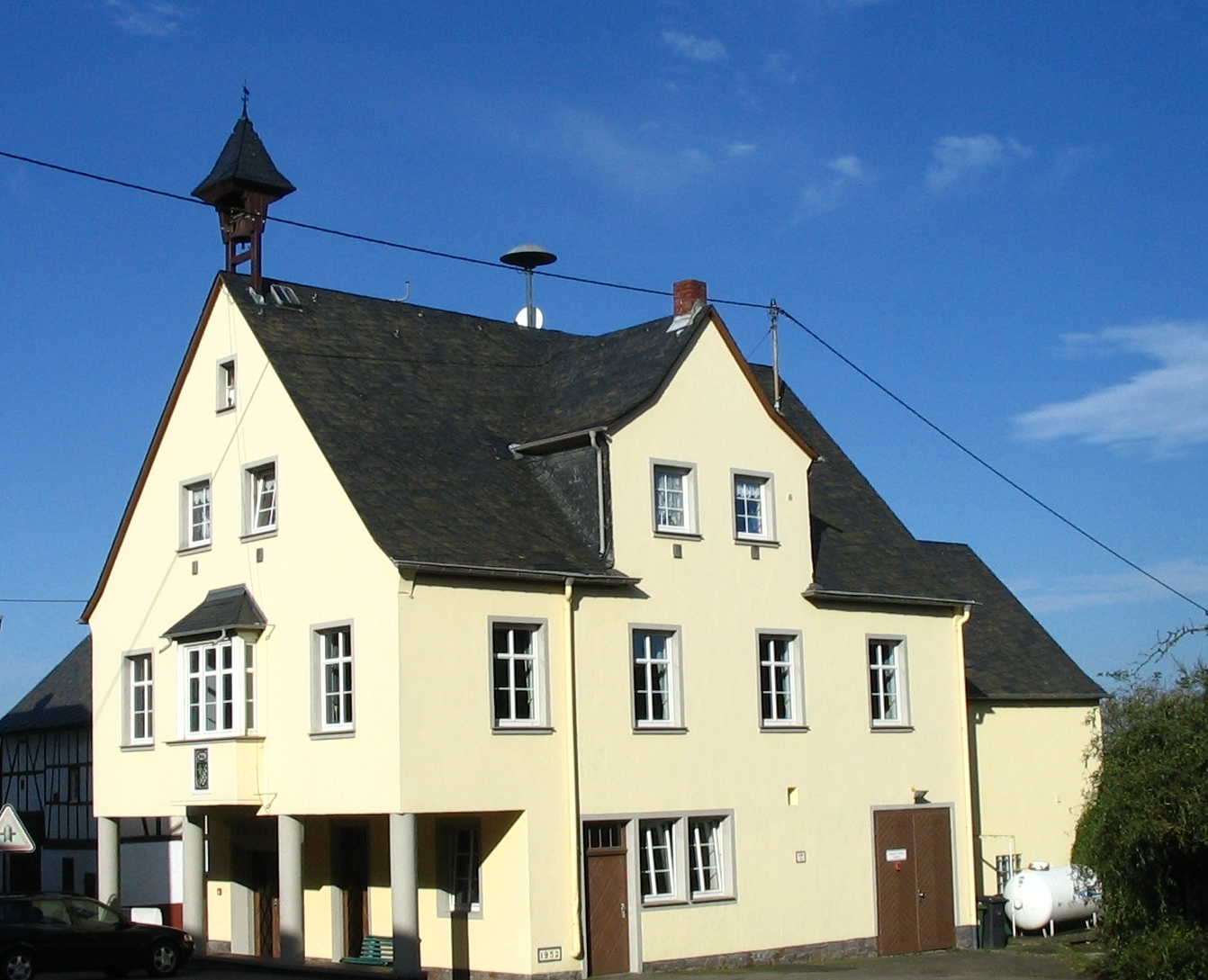|
Büchenbeuren
Büchenbeuren is an ''Ortsgemeinde'' – a municipality belonging to a ''Verbandsgemeinde'', a kind of collective municipality – in the Rhein-Hunsrück-Kreis (district) in Rhineland-Palatinate, Germany. It belongs to the ''Verbandsgemeinde'' of Kirchberg, whose seat is in the like-named town. Büchenbeuren is a state-recognized tourism municipality (''Fremdenverkehrsort''), and according to state planning, is laid out as a lower centre. Geography Location The municipality lies in the central Hunsrück northeast of the Idarwald (forest). Constituent communities Büchenbeuren is divided among the outlying ''Ortsteil'' of Scheid, part of Frankfurt-Hahn Airport and the main centre, also called Büchenbeuren. History In 1301, Büchenbeuren had its first documentary mention in a document from the comital family Sponheim. Nevertheless, it is believed to be roughly 300 years older than that. Büchenbeuren belonged until the end of the Middle Ages to the landholdings under the lor ... [...More Info...] [...Related Items...] OR: [Wikipedia] [Google] [Baidu] |
Büchenbeuren03
Büchenbeuren is an ''Ortsgemeinde'' – a municipality belonging to a ''Verbandsgemeinde'', a kind of collective municipality – in the Rhein-Hunsrück-Kreis (district) in Rhineland-Palatinate, Germany. It belongs to the ''Verbandsgemeinde'' of Kirchberg, whose seat is in the like-named town. Büchenbeuren is a state-recognized tourism municipality (''Fremdenverkehrsort''), and according to state planning, is laid out as a lower centre. Geography Location The municipality lies in the central Hunsrück northeast of the Idarwald (forest). Constituent communities Büchenbeuren is divided among the outlying ''Ortsteil'' of Scheid, part of Frankfurt-Hahn Airport and the main centre, also called Büchenbeuren. History In 1301, Büchenbeuren had its first documentary mention in a document from the comital family Sponheim. Nevertheless, it is believed to be roughly 300 years older than that. Büchenbeuren belonged until the end of the Middle Ages to the landholdings under the lor ... [...More Info...] [...Related Items...] OR: [Wikipedia] [Google] [Baidu] |
Büchenbeuren02
Büchenbeuren is an ''Ortsgemeinde'' – a municipality belonging to a ''Verbandsgemeinde'', a kind of collective municipality – in the Rhein-Hunsrück-Kreis (district) in Rhineland-Palatinate, Germany. It belongs to the ''Verbandsgemeinde'' of Kirchberg, whose seat is in the like-named town. Büchenbeuren is a state-recognized tourism municipality (''Fremdenverkehrsort''), and according to state planning, is laid out as a lower centre. Geography Location The municipality lies in the central Hunsrück northeast of the Idarwald (forest). Constituent communities Büchenbeuren is divided among the outlying ''Ortsteil'' of Scheid, part of Frankfurt-Hahn Airport and the main centre, also called Büchenbeuren. History In 1301, Büchenbeuren had its first documentary mention in a document from the comital family Sponheim. Nevertheless, it is believed to be roughly 300 years older than that. Büchenbeuren belonged until the end of the Middle Ages to the landholdings under the lor ... [...More Info...] [...Related Items...] OR: [Wikipedia] [Google] [Baidu] |
Niederweiler, Rhein-Hunsrück
Niederweiler is an ''Ortsgemeinde'' – a municipality belonging to a ''Verbandsgemeinde'', a kind of collective municipality – in the Rhein-Hunsrück-Kreis (district) in Rhineland-Palatinate, Germany. It belongs to the ''Verbandsgemeinde'' of Kirchberg, whose seat is in the like-named town. Geography Location The municipality is residential and characterized by agriculture and lies in the Hunsrück roughly 1 km south of Büchenbeuren. Just beyond Büchenbeuren is Frankfurt-Hahn Airport. Niederweiler's municipal area measures 4.81 km2, of which 1.45 km2 is wooded. History There are a great many prehistoric and Roman barrows on the ''Via Ausonia'', a Roman road (called the ''Ausoniusstraße'' in German). Unearthed there in 1926 was a Roman site, apparently a grave monument from the 2nd century, with a hefty base and a balustraded enclosure. Some of the finds made there can now be found in the Bonn State Museum (''Bonner Landesmuseum''). This monument stood rig ... [...More Info...] [...Related Items...] OR: [Wikipedia] [Google] [Baidu] |
Lautzenhausen
Lautzenhausen is an ''Ortsgemeinde'' – a municipality belonging to a ''Verbandsgemeinde'', a kind of collective municipality – in the Rhein-Hunsrück-Kreis (district) in Rhineland-Palatinate, Germany. It belongs to the ''Verbandsgemeinde'' of Kirchberg, whose seat is in the like-named town. Geography Location The municipality lies on a high plateau in the Hunsrück. Great parts of the municipal area are covered by Frankfurt-Hahn Airport. Lautzenhausen is linked to the long-distance road network by ''Bundesstraße'' 50. Lautzenhausen lies roughly east-southeast of the Moselle at Starkenburg and just under west-southwest of Simmern. The municipal area measures 495 ha. History Archaeological finds bear witness to a Roman presence in the area. In 1260, Lautzenhausen had its first documentary mention. Beginning in 1794, Lautzenhausen lay under French rule. In 1814 it was assigned to the Kingdom of Prussia at the Congress of Vienna. Since 1946, it has been part of the ... [...More Info...] [...Related Items...] OR: [Wikipedia] [Google] [Baidu] |
Rhein-Hunsrück-Kreis
Rhein-Hunsrück-Kreis is a district (german: Kreis) in the middle of Rhineland-Palatinate, Germany. The neighbouring districts are (from north clockwise) Mayen-Koblenz, Rhein-Lahn, Mainz-Bingen, Bad Kreuznach, Birkenfeld, Bernkastel-Wittlich, Cochem-Zell. History The district was created in 1969, when the districts of St. Goar and Simmern were merged. In 2014 it was expanded with the municipalities Lahr, Mörsdorf and Zilshausen, previously part of Cochem-Zell. Geography The name of the district already mentions the two main geographic features of the district - the river Rhine which forms the boundary to the north-east and the hills of the Hunsrück cover most of the area of the district. The Frankfurt-Hahn Airport is located in the district. Partnerships In 1962, Simmern began a friendship pact with the French region Bourgogne, which was continued after the merging with the St. Goar. In 1985 a partnership was started with the district Nyaruguru (at that time called the mu ... [...More Info...] [...Related Items...] OR: [Wikipedia] [Google] [Baidu] |
Bärenbach, Rhein-Hunsrück
Bärenbach is an ''Ortsgemeinde'' – a Municipalities of Germany, municipality belonging to a ''Verbandsgemeinde'', a kind of collective municipality – in the Rhein-Hunsrück-Kreis (Districts of Germany, district) in Rhineland-Palatinate, Germany. It belongs to the Kirchberg (Verbandsgemeinde), ''Verbandsgemeinde'' of Kirchberg, whose seat is in the Kirchberg, Rhein-Hunsrück, like-named town. Geography Location The municipality lies in the Hunsrück about 1 km east of the river Nahe (Rhine), Nahe. Rhineland-Palatinate's geographical midpoint is found within Bärenbach's municipal limits. A stone marks the spot at precisely where the midpoint lies. History Middle Ages and early modern times In 1103, Bärenbach had its first documentary mention. Between 1234 and 1437, Bärenbach belonged to the Upper Rhenish Circle, the Margraviate of Baden, the “Further” County of Sponheim and the ''Amt (country subdivision), Oberamt'' of Kirchberg. In this time, the Counts of Spo ... [...More Info...] [...Related Items...] OR: [Wikipedia] [Google] [Baidu] |
Kirchberg (Verbandsgemeinde)
Kirchberg is a ''Verbandsgemeinde'' ("collective municipality") in the Rhein-Hunsrück district, in Rhineland-Palatinate, Germany. Its seat is in Kirchberg. The ''Verbandsgemeinde'' Kirchberg consists of the following ''Ortsgemeinden'' ("local municipalities"): Verbandsgemeinde in Rhineland-Palatinate {{RheinHunsrück-geo-stub ... [...More Info...] [...Related Items...] OR: [Wikipedia] [Google] [Baidu] |
Belg
Belg is an ''Ortsgemeinde'' – a municipality belonging to a ''Verbandsgemeinde'', a kind of collective municipality – in the Rhein-Hunsrück-Kreis (district) in Rhineland-Palatinate, Germany. It belongs to the ''Verbandsgemeinde'' of Kirchberg, whose seat is in the like-named town. Geography The municipality lies in the central Hunsrück, right on the ''Hunsrückhöhenstraße'' (“Hunsrück Heights Road”, a scenic road across the Hunsrück built originally as a military road on Hermann Göring’s orders; the stretch running through Belg is nowadays designated ''Bundesstraße'' 327). History In 1295, Belg had its first documentary mention in connection with the Counts of Sponheim. This noble house enfeoffed two others with estates. As early as the 11th century, slate was being mined in the Belger Bachtal (valley), and 15 mines were still being worked into the 20th century. Beginning in 1794, Belg lay under French rule. In 1815 it was assigned to the Kingdom of Prussia at ... [...More Info...] [...Related Items...] OR: [Wikipedia] [Google] [Baidu] |
Altlay
Altlay is an ''Ortsgemeinde'' – a municipality belonging to a ''Verbandsgemeinde'', a kind of collective municipality – in the Cochem-Zell district in Rhineland-Palatinate, Germany. It belongs to the ''Verbandsgemeinde'' of Zell, whose seat is in the municipality of Zell an der Mosel. Geography The municipality lies in the north of the Hunsrück between Frankfurt-Hahn Airport (3 km to the south) and the Moselle at an elevation of some 300 m above sea level. North of the village, the Altlayer Bach flows through a narrow valley into the Moselle. Altlay lies 8 km southeast of Zell and 11 km northwest of the town of Kirchberg. History As early as 1107, the municipality was mentioned under the name ''Leia''. About 1489, slate mining near Altlay was mentioned. Beginning in 1794, Altlay lay under French rule. In 1815 it was assigned to the Kingdom of Prussia at the Congress of Vienna. Since 1946, it has been part of the then newly founded state of Rhine ... [...More Info...] [...Related Items...] OR: [Wikipedia] [Google] [Baidu] |
Serfdom
Serfdom was the status of many peasants under feudalism, specifically relating to manorialism, and similar systems. It was a condition of debt bondage and indentured servitude with similarities to and differences from slavery, which developed during the Late Antiquity and Early Middle Ages in Europe and lasted in some countries until the mid-19th century. Unlike slaves, serfs could not be bought, sold, or traded individually though they could, depending on the area, be sold together with land. The kholops in Russia, by contrast, could be traded like regular slaves, could be abused with no rights over their own bodies, could not leave the land they were bound to, and could marry only with their lord's permission. Serfs who occupied a plot of land were required to work for the lord of the manor who owned that land. In return, they were entitled to protection, justice, and the right to cultivate certain fields within the manor to maintain their own subsistence. Serfs were ofte ... [...More Info...] [...Related Items...] OR: [Wikipedia] [Google] [Baidu] |
Simmern
Simmern (; officially Simmern/Hunsrück) is a town of roughly 7,600 inhabitants (2013) in Rhineland-Palatinate, Germany, the district seat of the Rhein-Hunsrück-Kreis, and the seat of the ''Verbandsgemeinde'' Simmern-Rheinböllen. In the Rhineland-Palatinate state development plan, it is set out as a middle centre. Geography Location Simmern, through whose municipal area the 50th parallel of north latitude runs, lies in the Hunsrück in the so-called ''Simmerner Mulde'' (“Simmern Hollow”). The old town centre is found in the valley of the Simmerbach, while the newer neighbourhoods are spread over the surrounding heights. The Külzbach empties into the Simmerbach on the town's western outskirts. East of the town is a recreational area with a manmade lake, the Simmersee. South of the town is the town forest, which forms the edge of the Soonwald, a heavily wooded section of the west-central Hunsrück. The municipal area measures 1 196 ha. Of interest to visitors ar ... [...More Info...] [...Related Items...] OR: [Wikipedia] [Google] [Baidu] |
Rhin-et-Moselle
Rhin-et-Moselle (; ) was a department of the First French Republic and First French Empire in present-day Germany. It was named after the rivers Rhine and Moselle. It was formed in 1797, when the left bank of the Rhine was annexed by France. Until the French occupation, its territory was divided between the Archbishopric of Cologne, the Archbishopric of Trier, and the Electorate of the Palatinate. Its territory is now part of the German states of Rhineland-Palatinate and North Rhine-Westphalia. Its capital was Koblenz. After Napoleon was defeated in 1814, the department became part of Prussia. History The Département de Rhin-et-Moselle was established by the French First Republic in 1798 in the territories of the Holy Roman Empire conquered after the War of the First Coalition in 1794, after the failure of the creation of an independent Cisrhenian Republic. The annexation was legalized under international law by the Treaty of Lunéville on February 9, 1801. Since the French h ... [...More Info...] [...Related Items...] OR: [Wikipedia] [Google] [Baidu] |




